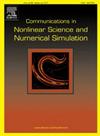Modeling and simulation of the conserved N-component Allen–Cahn model on evolving surfaces
IF 3.4
2区 数学
Q1 MATHEMATICS, APPLIED
Communications in Nonlinear Science and Numerical Simulation
Pub Date : 2025-03-10
DOI:10.1016/j.cnsns.2025.108745
引用次数: 0
Abstract
This paper establishes the conserved N-component Allen–Cahn model on evolving surfaces and conducts numerical simulations of the model. In mathematical modeling, since the surface motion velocity causes local contraction or expansion of the surface, it is hard to simultaneously fulfill the componential mass conservation and the point-wise mass conservation as the usual case on the static domain. Therefore, according to these two types of conservation, three models are established: the componential mass conservation model, the point-wise mass conservation model, and the componential and point-wise mass conservation model. For the numerical simulation, the evolving surface finite element method is used to discretize the model in time and space. To achieve a stable, linear, high-accuracy and decoupled numerical scheme, the evolving surface finite element method has been enhanced by incorporating the stabilized semi-implicit approach. Furthermore, the stability analysis has been undertaken to validate the robustness of the devised numerical scheme. Through the validation of numerous numerical simulations, the reasonableness of the proposed model and the efficacy of the numerical approach are evaluated.
演化曲面上守恒n分量Allen-Cahn模型的建模与仿真
本文在演化曲面上建立了守恒n分量Allen-Cahn模型,并对该模型进行了数值模拟。在数学建模中,由于表面运动速度引起表面的局部收缩或膨胀,在静态域上很难同时满足分量质量守恒和点向质量守恒。因此,根据这两种类型的守恒,建立了三种模型:分量质量守恒模型、点向质量守恒模型、分量和点向质量守恒模型。在数值模拟中,采用演化曲面有限元法对模型进行时间和空间离散。为了实现稳定、线性、高精度和解耦的数值格式,采用稳定半隐式方法对演化曲面有限元法进行了改进。此外,还进行了稳定性分析,验证了所设计数值格式的鲁棒性。通过大量的数值模拟验证,评价了所提模型的合理性和数值方法的有效性。
本文章由计算机程序翻译,如有差异,请以英文原文为准。
求助全文
约1分钟内获得全文
求助全文
来源期刊

Communications in Nonlinear Science and Numerical Simulation
MATHEMATICS, APPLIED-MATHEMATICS, INTERDISCIPLINARY APPLICATIONS
CiteScore
6.80
自引率
7.70%
发文量
378
审稿时长
78 days
期刊介绍:
The journal publishes original research findings on experimental observation, mathematical modeling, theoretical analysis and numerical simulation, for more accurate description, better prediction or novel application, of nonlinear phenomena in science and engineering. It offers a venue for researchers to make rapid exchange of ideas and techniques in nonlinear science and complexity.
The submission of manuscripts with cross-disciplinary approaches in nonlinear science and complexity is particularly encouraged.
Topics of interest:
Nonlinear differential or delay equations, Lie group analysis and asymptotic methods, Discontinuous systems, Fractals, Fractional calculus and dynamics, Nonlinear effects in quantum mechanics, Nonlinear stochastic processes, Experimental nonlinear science, Time-series and signal analysis, Computational methods and simulations in nonlinear science and engineering, Control of dynamical systems, Synchronization, Lyapunov analysis, High-dimensional chaos and turbulence, Chaos in Hamiltonian systems, Integrable systems and solitons, Collective behavior in many-body systems, Biological physics and networks, Nonlinear mechanical systems, Complex systems and complexity.
No length limitation for contributions is set, but only concisely written manuscripts are published. Brief papers are published on the basis of Rapid Communications. Discussions of previously published papers are welcome.
 求助内容:
求助内容: 应助结果提醒方式:
应助结果提醒方式:


